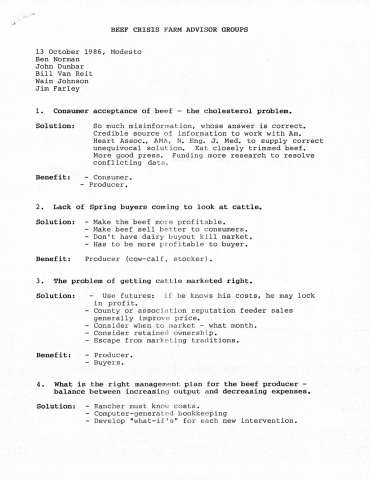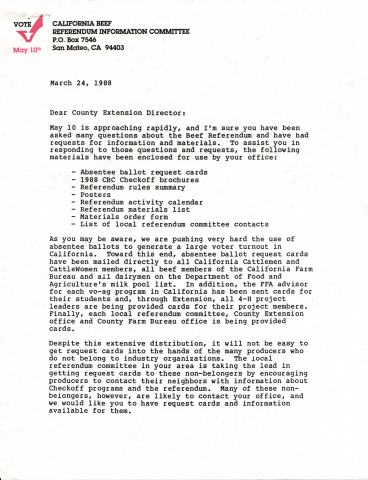Last month, the California Agricultural Resources Archive (CARA) team digitized and placed online over one hundred items from the Mariposa County, UC Cooperative Extension collection found in the California Agricultural Resources Archive. The records come from the office of Dr. Fadzayi Elizabeth Mashiri, current County director and Livestock and Natural Resources Advisor for Mariposa and Merced Counties.
One series in this collection contains materials related to livestock activities both locally and statewide. A particular set of documents were created to organize and promote the 1988 Beef Checkoff Program. This program, an outcome of the Beef Promotion and Research Act of the 1985 Farm Bill, authorizes the charge of “$1 per head on the sale of live domestic and imported cattle, in addition to a comparable assessment on imported beef and beef products… the Checkoff program was designed to stimulate restaurants and grocery stores to sell more beef and encourage consumers to buy more beef. This is accomplished through initiatives such as consumer advertising, marketing partnerships, public relations, education, research and new-product development.” (1) While the Checkoff Program was already active by 1988, the USDA, alongside statewide beef councils, organized a referendum to make this funding stream permanent. The California Beef Council created materials for beef producers (potential referendum voters), but also for UC Cooperative Extension offices around the state, as UCCE was delegated to handle logistics and to host voting sites.
A Beef Crisis Report, produced by the UC Cooperative Extension Beef Crisis Committee details the state of the industry in the eighties using information collected from interviews with fifty ranchers and other industry personnel. One issue detailed in the report concerns “consumer acceptance.” Ranchers reported that many consumers were turned off by the potential harmful effects of eating beef, like the presence of hormones and antibiotics. Another concern identified was that “production and financial records are often inadequate because of insufficient business management skills.” These are only just of a couple of challenges faced by the industry at this time.

Found in another document from the Beef Crisis Farm Advisors Group are succinct summaries of the various problems alongside potential solutions:

Registering to vote for the referendum and voting occurred on the same day (May 10th, 1988) but eligible voters could apply for an absentee ballot up to a month prior to the election. In this letter from the California Beef Referendum Information Committee, Cooperative Extension County Directors are reminded that they are “pushing very hard the use of absentee ballots to generate a large voter turnout in California.”

Using information shared by the California Beef Council, UC Cooperative Extension created materials for eligible voters to communicate key dates and requirements:

Brochures assured ranchers and beef producers that their money was going to good use:
Beef. Real Food for Real People.

The beef producer’s investment in beef producer profits

The 1988 Beef Checkoff passed with 78% of voters voting yes on the referendum, ensuring that money for research and marketing would be available on the statewide and national levels. Funds went to a range of advertising campaigns including the familiar “Beef. It’s What’s for Dinner.” commercials that permeated TV screens across the country in the nineties.
To view all of the digitized materials in the Mariposa County, UC Cooperative Extension archive click here.
We continue to process records from Mariposa County, including a large collection of photographs depicting 4-H youth development program activities in Mariposa County and will soon make these digitized items available on Calisphere.

